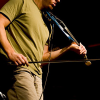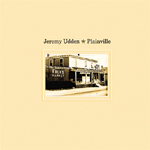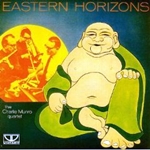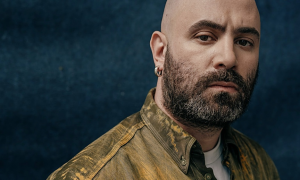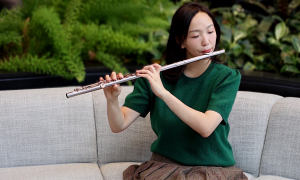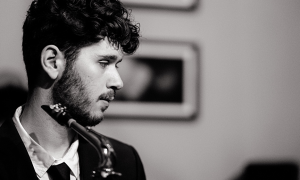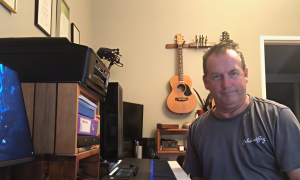Home » Jazz Articles » Take Five With... » Take Five With James Sudakow
Take Five With James Sudakow
 Meet James Sudakow: I am a 3rd generation classically trained violinist and started playing at the age of four. Despite the classical upbringing, I have always gravitated to rock, fusion, jazz, and progressive music. During my early twenties, I was invited to play in a band and hooked up electrically for the first time. That completely opened up an entirely new view I had of my instrument. After years of honing my own style, I released my debut all instrumental rock/fusion/progressive CD—Green, which received acclaim particularly in the progressive rock and fusion community. We have just released the follow up CD—There is no Sound in Space—which has an industrial electronica undertone but still has elements of fusion, rock, and improvisation.
Meet James Sudakow: I am a 3rd generation classically trained violinist and started playing at the age of four. Despite the classical upbringing, I have always gravitated to rock, fusion, jazz, and progressive music. During my early twenties, I was invited to play in a band and hooked up electrically for the first time. That completely opened up an entirely new view I had of my instrument. After years of honing my own style, I released my debut all instrumental rock/fusion/progressive CD—Green, which received acclaim particularly in the progressive rock and fusion community. We have just released the follow up CD—There is no Sound in Space—which has an industrial electronica undertone but still has elements of fusion, rock, and improvisation. Instrument(s):
Electric violin and Viola.
Teachers and/or influences? The classical upbringing clearly served as a strong foundation for me musically; however, despite being a classically trained violinist since childhood, my real influences were a combination of rock, jazz, fusion, and progressive guitarists for the most part. Obviously, Jean-Luc Ponty and Jerry Goodman played a huge role influencing me to follow those great pioneers of the electric violin, and I was particularly influenced by Goodman's playing in Mahavishnu Orchestra's 1973 release, Birds of Fire. Ironically, though, I was more influenced by the guitar work of John McLaughlin as well as other innovative guitarists. Jimi Hendrix was a huge influence on me as well specifically from the standpoint of being innovative about the kinds of sounds he could create with the guitar. Given my rock inclination, it was a great springboard to trying to really create as many different sounds as I could out of the electric violin.
Your sound and approach to music: My sound and approach to music is quite unconventional for a violinist—even an electric violinist. This is largely because of my heavily rock influence. I do pull from a large variety of music genres ranging from classical to jazz to fusion to rock, but I've always had a natural energy from rock. As such, I play through a Marshall amp with a variety of different kinds of distortion and feedback to try to create a really hard hitting fat, thick, and gritty sound at times but also try to balance that with classical, fusion, and improvisational elements to create an ebb and flow to the music.
Your favorite recording in your discography and why? I think my favorite two tracks from my discography would be "Red," from my first CD and "Strange Orange Glow," from my second CD. "Red" has a great energy to it and really runs the gamut on all of the things that you can do with an electric violin—from heavy distortion and crunchy rhythm parts to feedback, sound experimentation, to clean melody lines. The song—being 10 minutes in length—has a lot of ebbs and flows to it but has a really strong finishing climax, and I really love to play it live.
"Strange Orange Glow" is another favorite of mine. It has a heavily electronic percussion and bass line that serves as a foundation for me and guitarist, Eric Zimmermann to alternate with improvisation on top of it. I like this song because of the guitar/violin interaction and the different effects and sounds we create in this "back and forth dialogue." It's clearly one of the more esoteric tracks on the CD, but I really am proud of what we created there.
What do you think is the most important thing you are contributing musically? I think the most important thing that I am contributing to the musical world is creativity and innovation. For me, it's about thinking about the violin differently, and it's not merely about plugging the violin into an amplifier and proclaiming myself as an "electric violinist." It's much more about hearing the possibilities about what sounds the instrument can produce and thinking about those in a different way.
The violin has such incredible diversity in terms of the sounds it can create because it is fretless and uses a bow. Obviously, classical and jazz sounds are expected, but to be able to take it into more of a fusion and harder rock sound through creative styles of play and musical equipment just adds a degree of diversity that other stringed instruments don't have. Distortion, feedback, hard crunchy rhythm tracks have always been "guitar only" territory, but there's no reason why the violin can't play there, too, and I hope that's the contribution I'm making to music.
What is in the near future? For me, the most important next step in the near future is recording a live CD. We've had our first two studio recordings, which I think have come out great. The first CD—Green—was a power trio of electric violin, drums, and bass infused with some electronica and was a modern take on fusion with some rock influences. The second CD—There is no Sound in Space—was much more industrial electronica focused with alternating guitar and electric violin work.
For me, though, the greatest enjoyment comes from playing live, and when my trio plays all of our material live, we take it on its own path. I'd really like to capture that live feel and some of the different things we do with the songs when we play them live. We are in the process of getting some tour dates scheduled for later this year and next, and we plan on recording all of our shows to really capture that live sound.
Photo Credit
Sean P. Costello
Tags
PREVIOUS / NEXT
Support All About Jazz
 All About Jazz has been a pillar of jazz since 1995, championing it as an art form and, more importantly, supporting the musicians who make it. Our enduring commitment has made "AAJ" one of the most culturally important websites of its kind, read by hundreds of thousands of fans, musicians and industry figures every month.
All About Jazz has been a pillar of jazz since 1995, championing it as an art form and, more importantly, supporting the musicians who make it. Our enduring commitment has made "AAJ" one of the most culturally important websites of its kind, read by hundreds of thousands of fans, musicians and industry figures every month.


